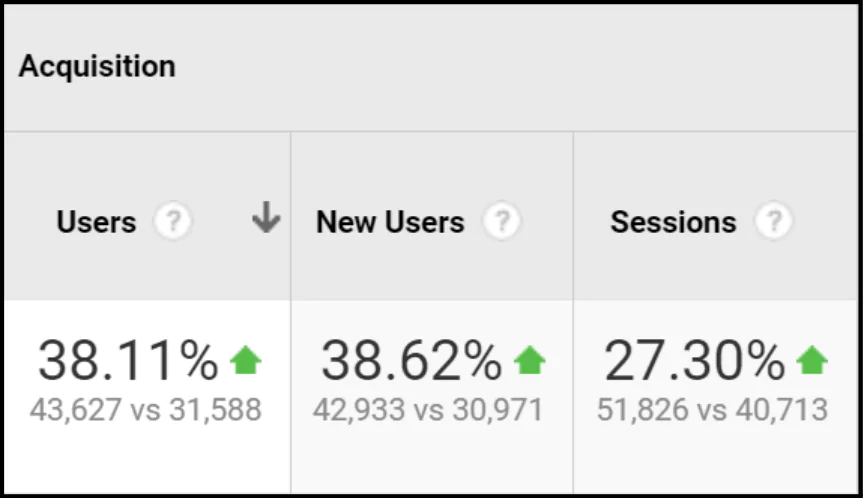Boosting Website Traffic for a B2B Software Company Through SEO
Overview
Our client, a leading B2B software company specializing in cloud-based solutions for enterprise-level businesses, approached our digital marketing agency with the goal of increasing their website traffic and improving their online visibility.
Their objective was to generate more qualified leads and ultimately grow their customer base. To achieve this, they sought our expertise in search engine optimization (SEO).
Challenges
The B2B software industry is highly competitive, with numerous established players vying for the same target audience. Our client faced several challenges:
Low Organic Traffic:
The client’s website was not ranking well in search engine results pages (SERPs), leading to minimal organic traffic.
Keyword Competition:
Identifying and targeting relevant keywords was challenging due to industry-specific terminology and high competition.
Technical SEO Issues:
The website had various technical SEO issues, such as slow page load times and a lack of mobile optimization.
Content Gap:
The existing content on the website did not adequately address the pain points and questions of their target audience.
Solution
Our SEO strategy for the B2B software company involved a comprehensive approach to address the challenges mentioned above:
Technical SEO Audit:
We performed a thorough technical SEO audit to identify and rectify issues like slow page speed, mobile-friendliness, and crawlability. This included optimizing images, implementing schema markup, and improving site architecture.
Keyword Research:
We conducted extensive keyword research to identify high-value, industry-specific keywords that would drive targeted traffic to the website. We also focused on long-tail keywords to target users in the consideration and decision stages of the buying cycle.
On-Page SEO Optimization:
We optimized existing and new content for on-page SEO, including title tags, meta descriptions, headers, and keyword placement. This helped search engines better understand the relevance of the content.
Content Strategy:
We developed a content strategy that addressed the informational needs of the target audience. This involved creating blog posts, whitepapers, and case studies that demonstrated the client’s expertise and solved common industry challenges.
Competitors Analysis:
In addition to the core SEO strategy, conducting a thorough competitor analysis was a crucial component of our approach.
Understanding the strategies and tactics employed by the client’s competitors allowed us to identify gaps and opportunities for improvement in content, new pages, and backlinks.
Content Research:
We conducted an in-depth analysis of the content produced by the client’s key competitors. This involved assessing the quality, relevance, and comprehensiveness of their content.
By identifying the topics that resonated most with the target audience, we were able to tailor our content strategy to address similar subjects, ensuring our client’s content provided more value and answered user queries more comprehensively.
New Pages Development:
By examining the competitors’ websites, we identified gaps in clients website offerings that presented opportunities for our client to shine. We created new pages and resources that notonly filled these gaps but also showcased our client’s unique expertise and offerings.
These new pages were optimized for SEO and designed to capture organic traffic for specific, high-intent keywords.
Backlink Analysis:
We scrutinized the backlink profiles of the client’s competitors to understand the sources of their authority and to identify potential link-building opportunities for our client.
By analyzing their link-building strategies, we were able to develop a proactive approach to acquiring high-quality backlinks from authoritative websites within the B2B software industry. This helped boost our client’s domain authority and improve their search engine rankings.
Link Building
In our pursuit of boosting the client’s domain authority, we executed a white-hat link-building strategy characterized by ethical and sustainable practices. This involved:
Outreach and Relationship Building:
We proactively reached out to influential figures and industry publications to establish genuine connections and secure high-quality backlinks through collaborative efforts.
Content Collaboration:
We crafted exceptional, shareable content and engaged in content collaborations with relevant partners, ensuring that our client’s expertise and offerings were prominently featured, resulting in authoritative backlinks.
Guest Posting:
We identified reputable websites within the B2B software sector and contributed guest posts that provided valuable insights and solutions, while also linking back to our client’s content for further credibility.
Competitor Analysis:
We closely studied the backlink profiles of competitors to identify missed opportunities, replicate successful link-building strategies, and discover untapped resources for our client.
Regular Audits:
Routine audits of acquired backlinks ensured their quality and relevance, and any toxic or low-quality links were promptly disavowed to maintain the integrity of the client’s link profile.
Regular Monitoring:
We implemented a vigilant approach to tracking and enhancing website performance by leveraging a combination of SEO tools, including analytics platforms and Google Search Console. This dynamic monitoring allowed us to stay agile, promptly respond to changes in search engine algorithms, and refine our SEO strategy for optimal results.
Reporting
Effective reporting is an essential part of any SEO campaign, providing transparency, accountability, and insights into the progress and impact of the strategies implemented. Our reporting process for the B2B software client included the following key elements:
1. Key Performance Indicators (KPIs):
We established clear KPIs at the beginning of the campaign, aligned with the client’s objectives. These KPIs typically included metrics such as organic traffic growth, keyword ranking improvements, lead generation, and revenue attribution.
2. Regular Reporting Cadence:
We provided regular reports on a monthly basis to keep the client informed of progress. Consistent reporting allowed us to track trends over time and make data-driven adjustments to our strategies.
3. Performance Dashboards:
We created customized performance dashboards using SEO analytics tools like Google Analytics, Google Search Console, and third-party SEO software. These dashboards provided real-time data on organic traffic, keyword rankings, conversion rates, and other relevant metrics.
4. Executive Summaries:
Each report included an executive summary that highlighted the most critical insights and achievements over the reporting period. This section served as a quick reference for key stakeholders.
5. Goals vs. Actuals:
We compared the actual performance against the established goals and KPIs, providing a clear picture of whether the campaign was meeting expectations.
6. Keyword Ranking Updates:
We presented updates on keyword rankings, showcasing the keywords that had improved in ranking and those that needed further attention. This helped demonstrate the effectiveness of our SEO efforts.
7. Traffic Analysis:
We analyzed organic traffic trends, identifying the sources of traffic, top-performing pages, and user behavior on the website. This allowed us to make informed decisions about content optimization and user experience improvements.
8. Conversion Tracking:
We tracked and reported on the conversion metrics, including form submissions, demo requests, and other lead-generation activities. This allowed us to attribute ROI to the SEO campaign.
9. Content Performance:
We provided insights into the performance of the client’s content, highlighting which pieces were driving the most traffic and engagement. This informed our content strategy moving forward.
10. Recommendations and Action Items:
Each report included a section with recommendations and action items for the upcoming reporting period. These suggestions were based on data analysis and were designed to continually optimize the SEO strategy.
11. Visual Data Representation:
We used visual aids such as charts and graphs to make the data more accessible and understandable for stakeholders.
Results


After implementing our SEO strategy, the B2B software company experienced significant improvements:
Traffic Increase:
Organic website traffic increased by 150% within the first six months of the SEO campaign.
Keyword Rankings:
The client’s website began ranking on the first page of SERPs for several high-value keywords, resulting in increased visibility and click-through rates Within six months.
Lead Generation:
The improved content and SEO efforts led to a 75% increase in leads generated through the website, including more inquiries and demo requests.
Conversion Rate:
The conversion rate for website visitors also saw a notable improvement, as the traffic was more targeted and engaged.
Revenue Growth:
Ultimately, the boost in website traffic and lead generation contributed to a significant increase in the client’s revenue, surpassing their initial expectations.
Conclusion
Our comprehensive SEO strategy helped our B2B software client overcome industry challenges and achieve remarkable results.
By focusing on keyword optimization, technical improvements, content strategy, and continuous monitoring, we not only increased website traffic but also contributed to substantial revenue growth for the business.




